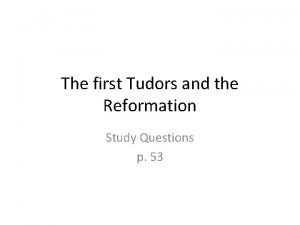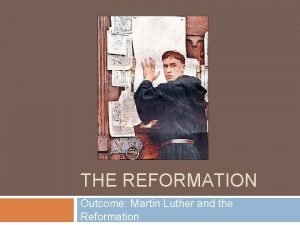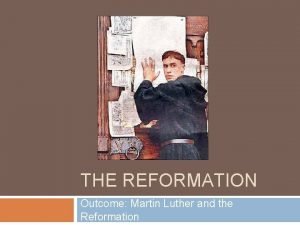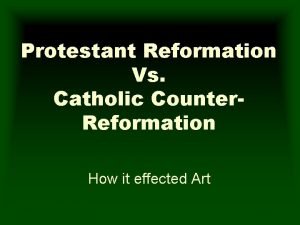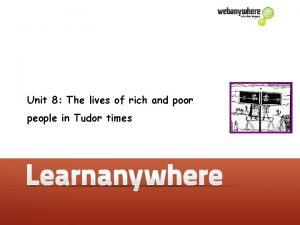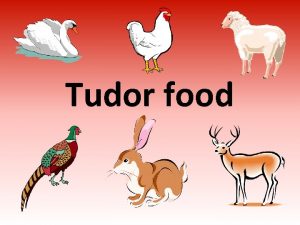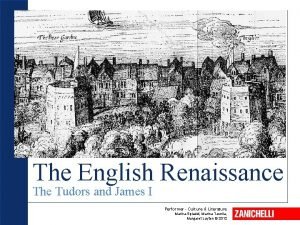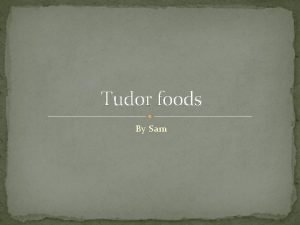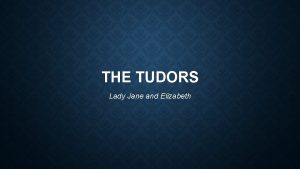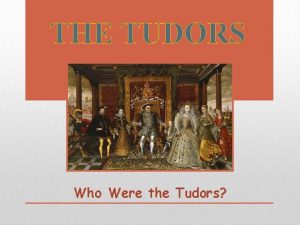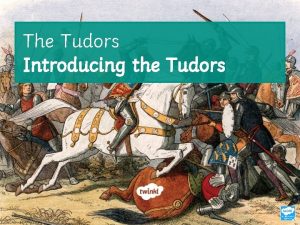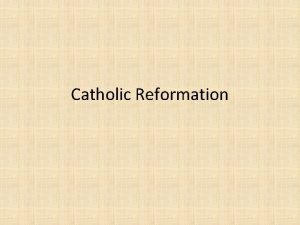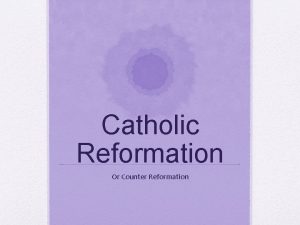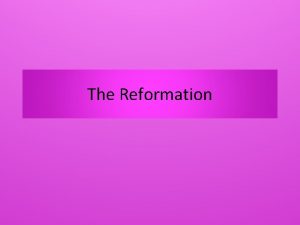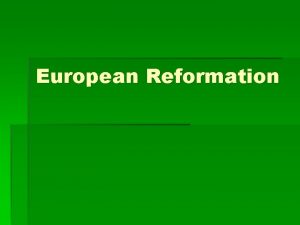The first Tudors and the Reformation Study Questions









- Slides: 9

The first Tudors and the Reformation Study Questions p. 53

• 1485 – End of the Wars of the Roses • The Lancastrian Henry Tudor becomes king with the title of Henry VII – not a member of the royal family; – need to justify the new Tudor dynasty through propaganda; – Shakespeare’s “Richard III” is good example of the Tudor propaganda, through which the old royals are presented as wicked while the Tudors look noble. • Henry VII’s reign is characterized by: – – – peace and prosperity, advantageous commercial treaties, development of trade and cloth industry, reorganization of navy and army, and the State administration, creation of a merchant fleet, political alliances with Spain and Scotland.

• 1509 – Henry VIII succeeds to the throne of England. • typical Renaissance prince: – – accomplished musician, poet and linguist; able and strong king and good soldier; capricious and cruel man; proclaimed “Defender of the Faith” by the Pope for his allegiance to the Catholic cause against Martin Luther. • Second half of his reign dominated by the Reformation: – Henry wants divorce from Catherine of Aragon and asks the Pope to grant it; – the Pope’s refusal leads to the “Act of Supremacy”, – The king is the Head of the Church of England; – the dissolution of monasteries brings great wealth to the Crown; – six successive wives and four advisers or ministers, the majority of whom are in the end executed: Sir Thomas More, the Earl of Surrey, and two of his wives, Anne Boleyn and Catherine Howard accused of being unfaithful.

• 1547 – Henry VIII’s son, Edward, a sickly 9 -year-old boy, succeeds to the throne of England with the title of Edward VI. • his reign is characterised by radical Protestantism and religious intolerance; – too young to rule; – his uncle, Edward Seymour, the Duke of Somerset, is made Lord Protector and rules in his place; – the Duke of Somerset is a keen Protestant; – the Reformation makes much progress: • new divine services are created, • the reading of the Bible is encouraged, • Catholics are persecuted • 1553 – Mary Tudor, Henry VIII and Catherine of Aragon’s daughter, becomes queen of England with the title of Mary I: – – the most serious attempt to restore Catholicism in England; marriage with Philip II of Spain, war with France – loss of Calais, last English possession in France; “Bloody Mary”, nickname given to Mary bvecause of the number of Protestants burned for heresy;

• 1558 – Anne Boleyn’s daughter, Elizabeth, comes to the throne of England with the title of Elizabeth I. • the last and the greatest of the Tudors • her reign – the most fortunate and glorious in English history characterised by stability and internal peace; • a woman endowed with political genius: – Initially, temporising and tolerant policy • makes peace with France and keeps on good terms with Spain; • refuses to marry Philip of Spain; • reintroduces Protestantism but never supported its strongly radical forms, like Puritanism; • Catholics who don’t attend Protestant services are only fined. – Later, stricter and tougher measures against Catholics are taken when Catholics plots to overthrow her are discovered.

During Elizabeth’s reign: – Expansion of the navy; – Development of overseas trade and colonies; – Support for exploration: • the most famous navigators, like Sir Francis Drake and Sir Walter Raleigh, were explorers and pirates at the same time. • they plundered the Spanish ships coming back with treasures from the New World with the unofficial encouragement and support of Queen Elizabeth herself. • main events of her reign – the voyages of discovery and the foundation of the first American colonies: • Sir Walter Raleigh founded the first colony in North America which was called Virginia in honour of Elizabeth, “the virgin Queen”; – the wars with Spain;

The competition with Spain resulted in an open war : – in 1588, a great fleet with an army aboard set sail to invade England; – The Invincible Armada was met in the Channel and defeated by the English fleet; – The rest of the Armada tried to reach Spain but half of the ships were wrecked by storms and most of the men perished. – The war was not ended but England was free from invasion. The Elizabethan Age was a great creative age in many fields: 1. 2. 3. 4. 5. 6. Literature (William Shakespeare); Philosophy (Francis Bacon); Science (William Harvey), the discoverer of the circulation of blood; Music; Architecture; Etc. In short, it was England’s Golden Age.

1. What distinguished the reign of the Tudor king Henry VII? – 2. How can we define Henry VIII? – 3. Pope Clement VII’s refusal to grant Henry VIII a divorce from Catherine of Aragon was the initial cause of the English Reformation, but there were political reasons too: above all England’s claim to be completely independent in fields like politics and religion. What did the Act of Supremacy establish? – 5. Henry VIII was a great monarch, a good soldier, a scholar and a man who loved to enjoy life. What was the reason for the English Reformation? – 4. A long period of stability and prosperity distinguished the reign of the first Tudor king. The army and the navy were reorganised and put under his direct control. A mercantile fleet was also created. Moreover, he reformed the entire machine of State administration. Finally, he laid the foundations of English Humanism. * It established that the Church of England was independent from the religious guidance of Rome ; the king was also the Head of the Church; the bishops were subject to the authority of the king not of the Pope. What political and social changes did the Reformation bring about? – After the Reformation the land wealth of the old monasteries were confiscated and given to the new Protestant aristocracy linked to the Tudors. Under the king’s guidance England set herself against the great Catholic powers of Europe: France and Spain. * Humanism is a philosophical and ethical position that emphasizes the value and agency of human beings, individually and collectively , and generally prefers critical thinking and evidence (rationalism, empiricism) over established doctrine or faith (fideism).

6. Which great humanist and king’s chief minister stood up against Henry VIII? – Sir Thomas More refused to recognise the authority of the king and remained faithful to the Church of Rome. Because of this he was tried and beheaded. 7. What characterized the reigns of Edward VI and Mary I? – The two reigns witnessed respectively the persecution of Catholics and then of Protestants.
 The first tudors and the reformation
The first tudors and the reformation The reformation outcome martin luther and the reformation
The reformation outcome martin luther and the reformation The reformation outcome martin luther and the reformation
The reformation outcome martin luther and the reformation Protestant reformation vs catholic reformation
Protestant reformation vs catholic reformation Tudor houses rich and poor
Tudor houses rich and poor Poor tudor menu
Poor tudor menu Tudor diet
Tudor diet The tudors zanichelli
The tudors zanichelli Poor tudor clothes
Poor tudor clothes Rich tudor food
Rich tudor food
